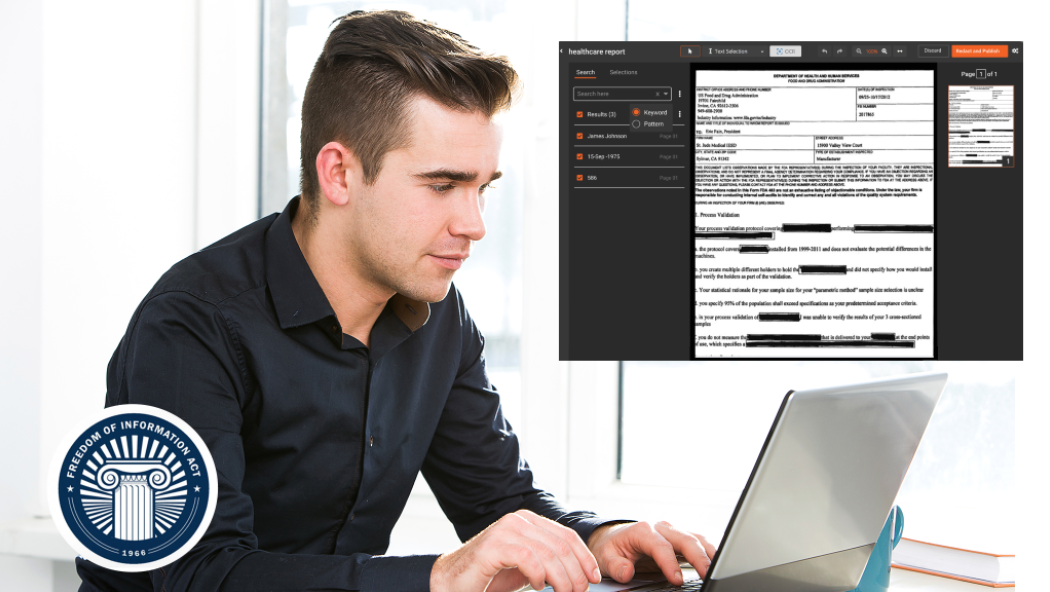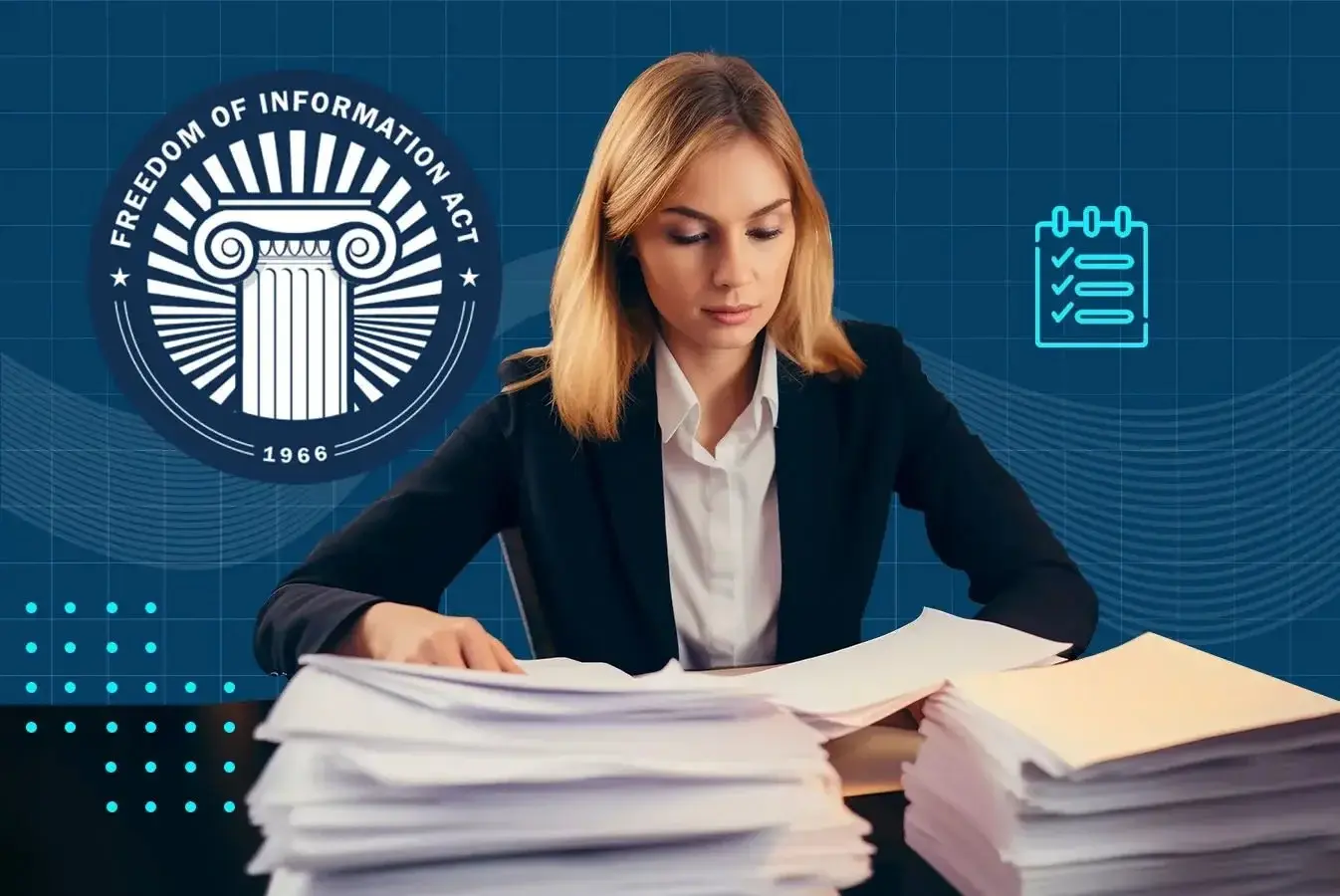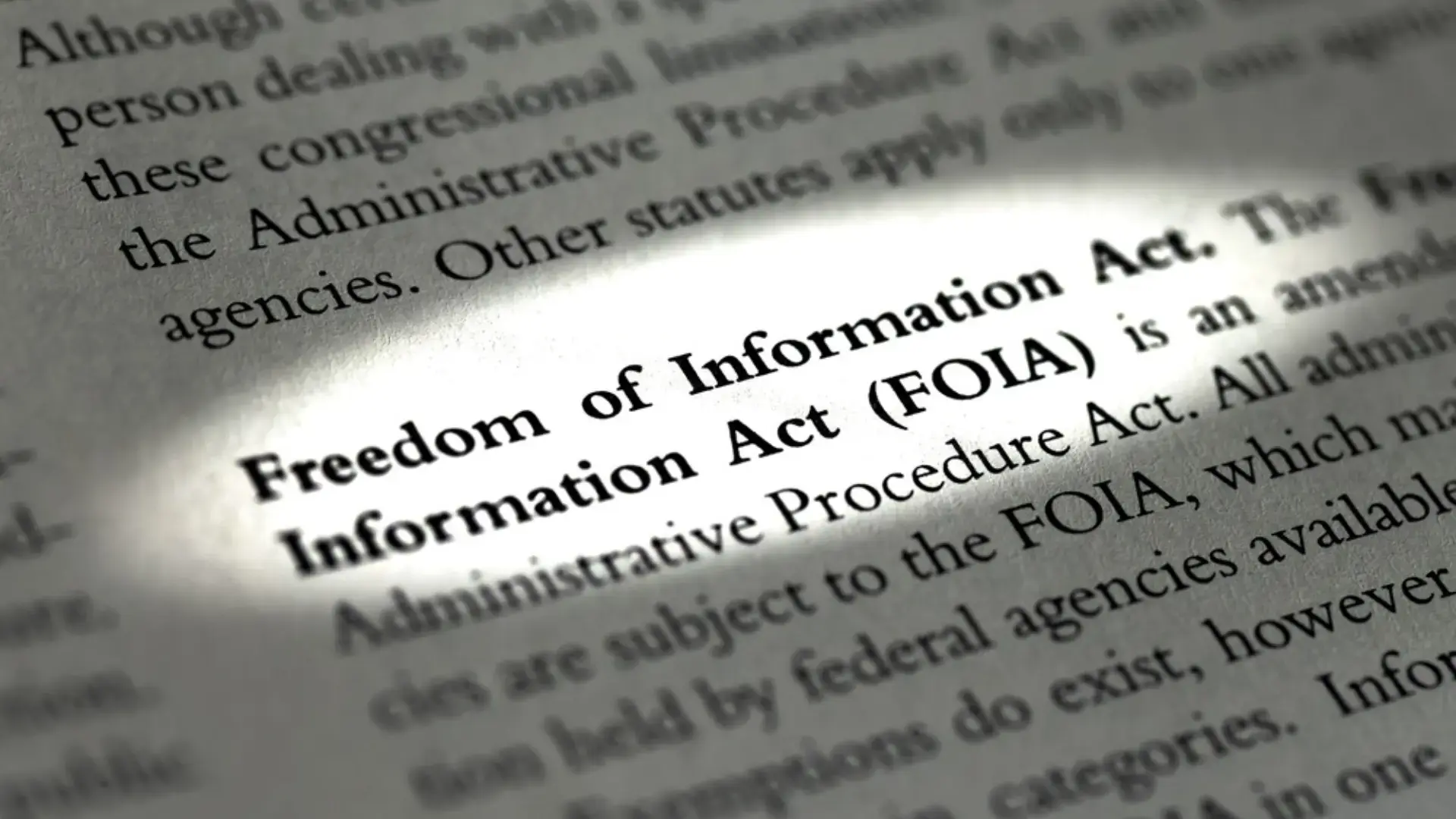FOIA Redaction Software for Handling FOIA Exemptions
by Rafey Iqbal, Last updated: November 19, 2025, Code:

FOIA redaction software is crucial for government agencies to process Freedom of Information Act requests efficiently and securely. Learn how automated redaction tools use AI to remove sensitive information (videos, audio, documents) in compliance with FOIA exemptions, solving the challenges of manual redaction and preventing data leaks.
The Freedom of Information Act (FOIA) compels transparency by allowing citizens to request government records. However, it also requires agencies to withhold (or redact) certain sensitive details before release.
FOIA Redaction Software is a specialized document redaction tool that automates this process, ensuring that exempt information is removed quickly and reliably. Without proper redaction, agencies risk exposing classified data, personal identifiers, or other protected details – leading to legal penalties and public trust issues.
In an era of rising FOIA requests and digital data, using AI-powered VIDIZMO Redactor technology has become essential for compliance, accuracy, and efficiency.
What is FOIA Redaction
The Freedom of Information Act (FOIA) compels transparency by allowing citizens to request government records. However, it also requires agencies to withhold (or redact) certain sensitive details before release. FOIA redaction software is a specialized document redaction tool that automates this process, ensuring that exempt information is removed quickly and reliably.
Without proper redaction, agencies risk exposing classified data, personal identifiers, or other protected details – leading to legal penalties and public trust issues. In an era of rising FOIA requests and digital data, using AI redaction technology has become essential for compliance, accuracy, and efficiency.
Why is FOIA Redaction Important
Even when a FOIA request is approved, not everything in a record can be shared. FOIA contains nine exemptions that permit agencies to withhold specific information (e.g., classified defense matters, personal privacy, law enforcement-sensitive data, etc.). Redacting such exempt information is mandatory before release.
Failure to properly redact can have serious consequences: unauthorized disclosure of personal or national security data can lead to privacy breaches, security threats, legal liability, and loss of public trust. Agencies have faced lawsuits and even criminal penalties for FOIA redaction failures.
For example, inadequate redaction once exposed a former CIA officer’s Social Security number and health information in a FOIA release. These risks underscore why robust redaction practices – and the software to enforce them – are crucial.
Challenges in Manual FOIA Redaction
Manual redaction (like blacking out text with markers or PDF editors) is increasingly unsustainable, given the volume and complexity of modern records. Federal agencies received a record high of 1.1 million FOIA requests in FY 2023, often involving lengthy documents, emails, PDFs, images, audio, and video files. Handling this workload by hand is time-consuming and prone to human error. Common pain points include:
- Tedious, Time-Intensive Process: Staff must review thousands of pages or hours of footage to identify sensitive content, making it hard to meet FOIA’s 20-business-day response deadline.
- Human Error and Oversights: Manually covering text can fail, leading to accidental disclosures.
- Multiple Formats Dilemma: FOIA requests include documents, images, videos, and audio recordings — which traditional methods cannot handle efficiently.
- Inadequate Traditional Tools: Basic software or marker-based redactions can be reversed if not done properly.
- High Compliance Risk: Agencies risk under-redacting (leading to data leaks) or over-redacting (violating transparency laws).
Importance of Understanding FOIA Exemptions
Of all FOIA requests received in 2022, a significant chunk was partially denied due to FOIA exemptions. The following graph shows the number of FOIA requests partially denied by each federal department in FY22:

FOIA Exemptions as a Balancing Tool
Decisions regarding what requests to grant or deny highly depend on FOIA exemptions. The 9 FOIA exemptions strike a balance of recognizing the public's right to know information while gatekeeping certain sensitive and critical information.
FOIA exemptions help ensure that this balance is maintained. A poor understanding of FOIA exemptions can have the opposite effect. Not fully understanding them can cause severe damage, including penalties, imprisonment, and reputational damage.
Exploring the 9 FOIA Exemptions

Knowing what information is exempted from public disclosure under FOIA is a prerequisite to understanding FOIA exemptions. The 9 FOIA exemptions are as follows:
Exemption 1: The first exemption applies to classified information that, if disclosed, could threaten and compromise national security.
Exemption 2: The second exemption concerns information regarding internal personnel rules and the agency's practices in carrying out its activities.
Exemption 3: If another law prohibits disclosing information of a specific nature, the third exemption must comply with the law.
Exemption 4: The fourth exemption deals with trade secrets and other commercial or financial information obtained from a person that is privileged or confidential.
Exemption 5: The fifth exemption includes privileged communications within or between agencies, including those protected by deliberative process privilege, attorney-work product privilege, and attorney-client privilege.
Exemption 6: The sixth exemption encompasses all information that, upon disclosure, can cause an invasion of another individual's privacy.
Exemption 7: The seventh exemption covers any information compiled for law enforcement purposes.
Exemption 8: The eighth exemption prohibits information disclosure regarding some reports available within an agency responsible for regulating or supervising financial institutions.
Exemption 9: The ninth exemption constitutes geological and geophysical information and data (including maps) of wells.
How Federal Agencies Can Ensure a Healthy FOIA Program
Effectively managing FOIA requests requires a strategic approach that balances transparency with compliance. Federal agencies must implement efficient redaction processes to protect sensitive information while maintaining public trust.
The Need for Advanced FOIA Redaction Software
It must be evident now that deciphering FOIA exemptions is integral to ensuring a healthy FOIA program. But the question is HOW? It is tedious to redact specific information manually in the face of increasing FOIA requests and massive amounts of data. However, advanced automated redaction software can significantly help agency personnel process FOIA requests.
FOIA redaction software directly addresses these issues with automation, accuracy, and compliance features:
- Automation and Speed: Software can scan thousands of pages, automatically detecting and redacting sensitive content.
- Multi-Format Redaction: Advanced tools handle documents, PDFs, images, videos, and audio with AI-powered recognition.
- Accuracy with AI Detection: AI-driven tools identify and redact personally identifiable information (PII) and other sensitive data across multiple formats.
- Compliance and Rule Enforcement: Built-in FOIA exemption templates ensure that all redactions align with legal requirements.
- Standardization and Consistency: AI ensures that redactions are applied uniformly across documents and multimedia files.
- Security and Irreversibility: Unlike manual methods, redacted content is completely removed, ensuring compliance and data security.
Key Features to Look for in VIDIZMO FOIA Redaction Software
When selecting FOIA redaction software, agencies should prioritize the following features:
- AI-Powered Detection: VIDIZMO Redactor leverages AI and machine learning to automatically detect and redact sensitive information across text, images, videos, and audio files.
- Multi-Format Support: The software supports redaction for a variety of formats, including PDFs, Word documents, videos, audio files, and images, ensuring that agencies can process all types of FOIA requests.
- Automated Redaction & Bulk Processing: VIDIZMO Redactor provides automated batch processing, enabling agencies to redact multiple files simultaneously, drastically reducing the time required to process large-scale FOIA requests.
- Pattern-Based PII Redaction: Using built-in pattern detection, VIDIZMO Redactor can automatically identify and remove personally identifiable information (PII) such as Social Security numbers, email addresses, phone numbers, and more.
- Customizable Exemption Codes & Labels: Agencies can apply FOIA exemption codes and labels to redacted content, ensuring compliance with FOIA guidelines while maintaining transparency in disclosures.
- Audit Logs and User Management: VIDIZMO Redactor maintains detailed audit logs, tracking every redaction action performed and providing agencies with full accountability and compliance reporting.
- Secure Redact and Storage: The software ensures that redacted content is permanently removed, preventing unauthorized recovery. It also offers role-based access control, ensuring only authorized personnel can access sensitive files.
- Integration and Workflow Features: VIDIZMO Redactor integrates with existing FOIA management systems, cloud storage, and records management platforms, ensuring an efficient and automated redaction workflow.
learn more about VIDIZMO Redactor.
Conclusion
Ignoring FOIA exemptions is not an option. Familiarizing yourself with them is immensely important since the stakes are high. After all, whether unintentional or intentional, disclosing such information can harm an individual and even an entire nation. Agency personnel paying little to no heed to FOIA exemptions can land in hot waters.
Handling FOIA requests requires balancing transparency and security. Given the rising number of FOIA requests and the complexity of redacting sensitive data, FOIA redaction software is now necessary. By automating redaction, agencies can improve efficiency, accuracy, and compliance while avoiding legal risks. Investing in AI-powered automated redaction technology ensures that exempt information is properly removed, allowing government agencies to fulfill their FOIA obligations without compromising security.
Learn more about VIDIZMO Redactor, or contact us today to discuss your needs and explore how we can help.
Alternatively, you may request a free trial and experience FOIA Redaction Software firsthand to efficiently redact sensitive information, ensuring compliance with FOIA exemptions. 
People Also Ask
What is FOIA redaction software and why do agencies need it?
FOIA redaction software is an automated redaction tool that helps government agencies remove exempt information from records, ensuring compliance with FOIA regulations and protecting sensitive data.
How does FOIA redaction software handle video and audio files?
Advanced tools use AI-powered video redaction software to blur faces or mute speech, ensuring all FOIA-exempt content is removed before public release.
Can FOIA redaction software redact Personally Identifiable Information (PII) automatically?
Yes, PII redaction software can detect and remove sensitive information such as names, addresses, and social security numbers automatically.
How is AI used in FOIA redaction, and is it reliable?
AI redaction ensures accuracy by identifying patterns in text, images, and speech to detect and redact sensitive content reliably.
What are the FOIA exemptions, and does redaction software know them?
FOIA redaction software includes templates for all nine FOIA exemptions, automatically applying the correct redaction criteria.
Jump to
You May Also Like
These Related Stories

State FOI Laws and How FOIA Redaction Software Helps You Comply

How to Follow FOIA Rules Using FOIA Redaction Software


No Comments Yet
Let us know what you think